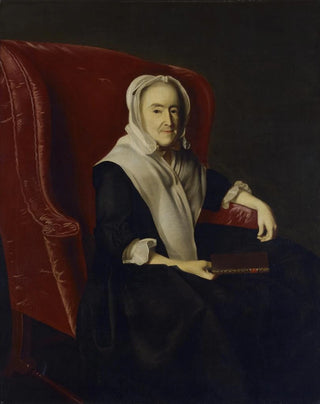Art print | Mrs. John Powell, Anna Susan Dummer - John Singleton Copley


View from behind

Frame (optional)
In the world of painting, some works transcend their era to become timeless icons. The art print of "Mme John Powell, Anna Susan Dummer" by John Singleton Copley is a perfect example. This piece, which captures with remarkable finesse the beauty and elegance of its subject, transports us to 18th-century America, a pivotal period when art began to reflect the aspirations of a society in full transformation. Through the penetrating gaze of young Anna Susan Dummer, Copley invites us to explore not only the portrait of a woman but also the nuances of a time when refinement and culture intertwined with daily life.
Style and uniqueness of the work
Copley's style is distinguished by its realistic approach and its ability to breathe an almost palpable life into its subjects. In this piece, the brightness of the colors and the precision of the details testify to his technical skill. The delicate drapery of Anna's dress, as well as the carefully chosen accessories, reveal not only her social status but also the importance given to fashion and personal presentation in the 18th century. The composition, balanced and harmonious, guides the viewer's eye across the painting, allowing for a complete immersion into the atmosphere of the period. Copley does not merely paint a portrait; he captures the very essence of his subject, transforming a simple representation into an open window onto a life imbued with grace and dignity.
The artist and his influence
John Singleton Copley, an emblematic figure of American art, knew how to mark his era with his exceptional talent and his commitment to realism. Born in Boston in 1738, he evolved in an environment where European art was revered, but he developed a style that was uniquely his own, blending British and American influences. Copley was not only a renowned portraitist but also played a crucial role in the emergence of an American artistic identity. His work inspired many artists, both through his technique and his ability to capture the soul of his models. Through portraits like that of Mme John Powell, he paved the way for a new

Matte finish

View from behind

Frame (optional)
In the world of painting, some works transcend their era to become timeless icons. The art print of "Mme John Powell, Anna Susan Dummer" by John Singleton Copley is a perfect example. This piece, which captures with remarkable finesse the beauty and elegance of its subject, transports us to 18th-century America, a pivotal period when art began to reflect the aspirations of a society in full transformation. Through the penetrating gaze of young Anna Susan Dummer, Copley invites us to explore not only the portrait of a woman but also the nuances of a time when refinement and culture intertwined with daily life.
Style and uniqueness of the work
Copley's style is distinguished by its realistic approach and its ability to breathe an almost palpable life into its subjects. In this piece, the brightness of the colors and the precision of the details testify to his technical skill. The delicate drapery of Anna's dress, as well as the carefully chosen accessories, reveal not only her social status but also the importance given to fashion and personal presentation in the 18th century. The composition, balanced and harmonious, guides the viewer's eye across the painting, allowing for a complete immersion into the atmosphere of the period. Copley does not merely paint a portrait; he captures the very essence of his subject, transforming a simple representation into an open window onto a life imbued with grace and dignity.
The artist and his influence
John Singleton Copley, an emblematic figure of American art, knew how to mark his era with his exceptional talent and his commitment to realism. Born in Boston in 1738, he evolved in an environment where European art was revered, but he developed a style that was uniquely his own, blending British and American influences. Copley was not only a renowned portraitist but also played a crucial role in the emergence of an American artistic identity. His work inspired many artists, both through his technique and his ability to capture the soul of his models. Through portraits like that of Mme John Powell, he paved the way for a new






